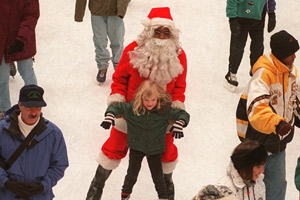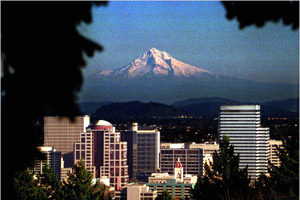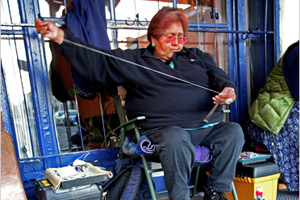Focus on America
Christmas, celebrated by most Christians on December 25.

Christmas, celebrated by most Christians on December 25, commemorates the birth of Jesus of Nazareth. Americans, like many of the world’s peoples, have developed their own Christmas traditions and observances, and these have changed greatly over time.
Today, most Americans blend religious and secular customs with their own family traditions. Thus, even though Christmas is for many Americans a religious occasion, the federal courts have upheld its status as a legal holiday. As one court reasoned, “by giving federal employees a paid vacation day on Christmas, the government is doing no more than recognizing the cultural significance of the holiday.”
DEVELOPMENT OF THE AMERICAN CHRISTMAS
The early New England Puritans frowned on the often boisterous Christmas celebrations they witnessed in Britain. In 1659, the Massachusetts colony briefly criminalized observance of the day and Christmas remained a regular workday in much of New England and Pennsylvania. Other parts of British North America, however, celebrated with gusto, with costumed revelers passing door to door and receiving small gifts of food and drink.
The modern, more commercialized Christmas began to emerge in the 19th century with the new custom of purchasing gifts for young children. Seasonal “Christmas shopping” began to assume economic importance.
Other Christmas traditions similarly began during the 19th century. Santa Claus -- derived from the Dutch Sinter Klaas and the German Saint Nicholas -- assumed the persona of a jolly dispenser of gifts and pilot of a reindeer-drawn sleigh through such works as the 1823 poem “A Visit from Saint Nicholas” and an 1863 Harper’s Weekly portrait by the illustrator Thomas Nast. Many organizations, from the Salvation Army charitable organization to the Coca-Cola Company, since have employed Santa’s image.
According to legend, Christmas trees date back to Martin Luther, the 16th century German cleric whose critique of established Catholic Church practices precipitated the Protestant Reformation. According to legend, Luther brought home to his children and lit with candles a fir tree one Christmas Eve to remind them of the wonders of God’s creation.
The custom spread to Britain and the United States in the 19th century. Today, many contemporary Americans either purchase a cut, fresh evergreen tree or a reusable aluminum and plastic model. Placed in the family living room, the Christmas tree is decorated with lights and various ornaments, typically small orbs depicting angels and other figures associated with the holiday. In some families, Christmas gifts appear under the tree on the morning of December 25, deposited there by family members, or, as smaller children might believe, delivered by Santa Klaus after landing reindeer and sleigh on the roof and traversing the chimney -- all after the children are fast asleep!
Mass-produced Christmas cards began to appear in the last quarter of the 19th century. In 1996, Americans purchased and mailed an estimated 2.6 billion Christmas cards. These might depict religious scenes or else convey more secular, often humorous, messages. With the rise of the Internet, electronically transmitted “e-cards” are an increasingly popular option.
CONTEMPORARY OBSERVANCES
Skaters celebrate Christmas in New Yorks Rockefeller Center. (© AP Images)
With Christmas shopping vitally important to some retailers, Christmas has expanded into a “season” of its own. During the Great Depression in the 1930s, President Franklin D. Roosevelt proposed moving the Thanksgiving holiday to extend the shopping period between that holiday and Christmas. Today, the day after Thanksgiving is known as “Black Friday.” An important shopping day (some stores open hours before their normal time), it pushes some businesses into profitability, or “in the black,” and can account for a substantial proportion of annual profits.
This extended Christmas season is about far more than shopping. For many Americans, it is a period of general good will and an occasion for charitable and volunteer work. To some extent, non-Christian holidays celebrated at roughly the same time of year -- most prominently the African-American Kwanzaa and the Jewish Hanukkah -- blend into a broader “holiday season.”
Seasonal popular entertainment includes a number of perennial favorites. Popular telecasts of the motion pictures A Miracle on 34th Street (1945) and It’s A Wonderful Life (1946) have been joined in recent years by A Christmas Story (1983), based on the tales of the radio raconteur Jean Shepherd.
Christmas-themed animated programs often appear on television. Some, like A Charlie Brown Christmas and Rudolph the Red-Nosed Reindeer, date to the mid-1960s, and are enjoyed by today’s children and their nostalgic parents alike.
An increasing number of radio stations now adjust their formats to feature Christmas music, sometimes exclusively, during the four weeks to six weeks before the holiday. Live and recorded performances of such classical favorites as the “Hallelujah Chorus” from Handel’s Messiah, Tchaikovsky’s Nutcracker Suite and J.S. Bach’s “Christmas Oratorio” peak during the weeks before Christmas.
The holiday’s original religious meaning remains for many its most important element. Some congregations create manger scenes -- dioramas of the stable where Jesus was born, complete with figurines representing the infant Jesus and those present at his birth. Many churches hold well-attended Christmas Eve candlelight or midnight services. Some include a Mass of the Nativity or a dramatization of the birth of Jesus.
As with so many aspects of U.S. cultural life, Christmas in the United States reflects the values of a free and diverse people.
Recently on Focus on America
Wealth and Hard Times Mingle in Northwest Oregon
 The Oregon 1st Congressional District stretches from a vibrant metropolitan area, across densely packed suburbs and rolling farm country through the mists of forested hills before ending on one of the world’s most spectacular coastlines.
The Oregon 1st Congressional District stretches from a vibrant metropolitan area, across densely packed suburbs and rolling farm country through the mists of forested hills before ending on one of the world’s most spectacular coastlines.
History, Culture and Science Shape Central New Mexico
 New Mexico’s 1st Congressional District is a swing district in a swing state. Situated in the geographic center of this southwest border state, the district climbs from desserts to mountains.
New Mexico’s 1st Congressional District is a swing district in a swing state. Situated in the geographic center of this southwest border state, the district climbs from desserts to mountains.
Love of Books Survives in an Electronic Age
 It probably never was the dream of Nancy Pearl, author of Book Lust, to be the model for a “shushing” librarian action figure. Yet the bespectacled Pearl is not unpleased.
It probably never was the dream of Nancy Pearl, author of Book Lust, to be the model for a “shushing” librarian action figure. Yet the bespectacled Pearl is not unpleased.